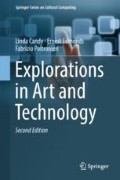Abstract
This chapter discusses a practice based action research approach to the study of art and technology. Such research seeks to find an understanding of the creative process drawing on knowledge from other fields. We consider ways in which creative practice can be studied based upon methodologies from the social sciences and the Human Computer Interaction. Included is an account of how this was achieved in the COSTART (COmputer SupporT for ARTists) project, which was concerned with the nature of creative collaboration in digital art practice . The chapter describes the research approach, one that enabled the artists involved to take a significant role in the research rather than have them confined to being purely subjects of study. The core chapter is followed by nine contributions on the subject from artists and researchers.
Access this chapter
Tax calculation will be finalised at checkout
Purchases are for personal use only
References
Avison DE, Wood-Harper AT (1991) Information systems development research: an exploration of ideas in practice. Comput J 34(2)
Boden MA (1990) The creative mind: myths and mechanisms. Weidenfeld and Nicolson, London
Bruce M (1993) Case study method in design. Des Stud 14(4)
Candy L (1995) The twin paths of research and design: reformulating the computer system development process. J Des Sci Technol 4(1):57–72 (Europia Productions)
Candy L, Edmonds EA (1994) Artefacts and the designer’s process: implications for computer support to design. J Des Sci Technol 3(1):11–31
Candy L, Edmonds EA (1996) Creative design of the lotus bicycle: implications for knowledge support systems research. Des Stud 17(1):71–90
Card SK, Moran TP, Newell A (1983) The psychology of human-computer interaction. Lawrence Erlbaum Associates, Hillsdale, New Jersey, London
Carroll JM, Kellogg WA, Rosson MB (1991) The task-artifact cycle. In: Carroll JM (ed) Designing interaction: psychology at the human-computer interface. Cambridge University Press, New York
Cohen H (1995) The robotic artist: aaron in living color. The Computer Museum, Boston
COSTART Project Web Site. http://research.it.uts.edu.au/creative/COSTART/
Edmonds EA, Candy L (1999) Computation, interaction and imagination: into virtual space and back to reality. In Gero J, Maher M (eds) Proceedings computational models of creative design, pp. 19–31
Gomringer E (1998) Manfred mohr-cubist in the computer age. In Algorithmic works (Manfred Mohr), Josef Albers Museum, Bottrop, pp 5–7
Guindon R, Krasner H, Curtis B (1987) Cognitive processes in software design. In: Proceedings of the 2nd IFIP conference on human computer interaction- INTERACT’87, North-Holland, pp 383–388
Lewin K (1951) Field theory in social science. Basic Books, New York
Maccoby M (1991) The innovative mind at work. In: IEEE spectrum, pp 23–35
Marchionini G, Sibert J (1991 Oct) An agenda for human-computer interaction: science amd engineering serving human needs. SIGCHI Bull 23(4):17–32 (ACM Press, New York)
Mumford E (1981) Participative system design: structure and method. Syst, Objectives, Solutions 1(1):5–19
Norman D (1988) The psychology of everyday things. Basic Books, NY
Suchman L (1987) Plans and situated actions. Cambridge University Press, Cambridge
Ullman DG, Dietterich TG, Stauffer L (1988) A model of the mechanical design process based on empirical data. AI EDAM 2(1):33–52
Warmington A (1980) Action research: its methods and its implications. J Appl Syst Anal 7
Winograd T, Flores F (1986) Understanding computers and cognition: a new foundation for design. Ablex Publishing Corporation, Norwood, NJ
Author information
Authors and Affiliations
Corresponding author
Rights and permissions
Copyright information
© 2018 Springer-Verlag London Ltd., part of Springer Nature
About this chapter
Cite this chapter
Candy, L., Edmonds, E., Poltronieri, F. (2018). Theme: Research. In: Explorations in Art and Technology. Springer Series on Cultural Computing. Springer, London. https://doi.org/10.1007/978-1-4471-7367-0_18
Download citation
DOI: https://doi.org/10.1007/978-1-4471-7367-0_18
Published:
Publisher Name: Springer, London
Print ISBN: 978-1-4471-7366-3
Online ISBN: 978-1-4471-7367-0
eBook Packages: Computer ScienceComputer Science (R0)

